Practice Free AZ-104 Exam Online Questions
HOTSPOT
You have an Azure subscription that contains the resource groups shown in the following table.

RG1 contains the resources shown in the following table.

RG2 contains the resources shown in the following table.

You need to identify which resources you can move from RG1 to RG2, and which resources you can move from RG2 to RG1.
Which resources should you identify? To answer, select the appropriate options in the answer area. NOTE: Each correct selection is worth one point.
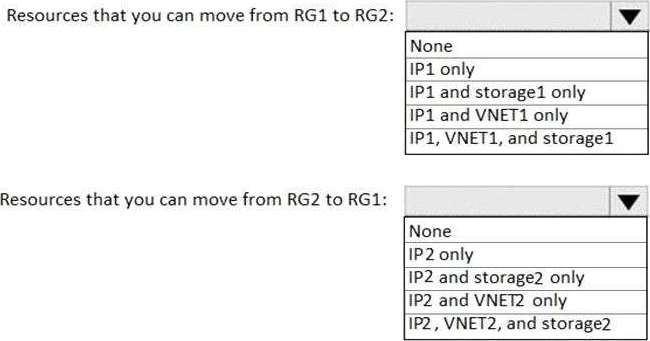
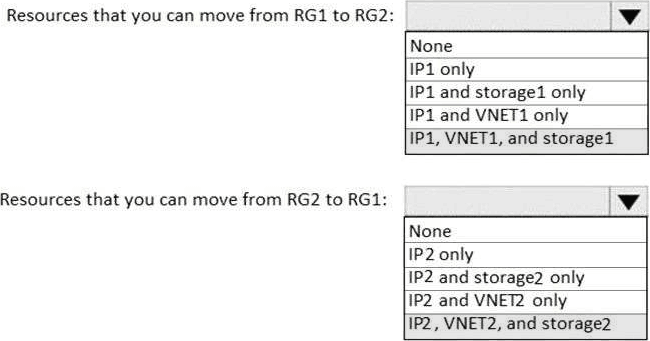
You have an Azure subscription that contains a virtual machine named VM1.
You have an on-premises datacenter that contains a domain controller named DC1. ExpressRoute is used to connect the on-premises datacenter to Azure.
You need to use Connection Monitor to identify network latency between VM1 and DC1.
What should you install on DC1?
- A . the Log Analytics agent
- B . the Azure Network Watcher Agent virtual machine extension
- C . an Azure Monitor agent extension
- D . the Azure Connected Machine agent for Azure Arc-enabled servers
You have an Azure subscription that contains the resources in the following table.

VM1 and VM2 are deployed from the same template and host line-of-business applications accessed by using Remote Desktop.
You configure the network security group (NSG) shown in the exhibit. (Click the Exhibit button.)
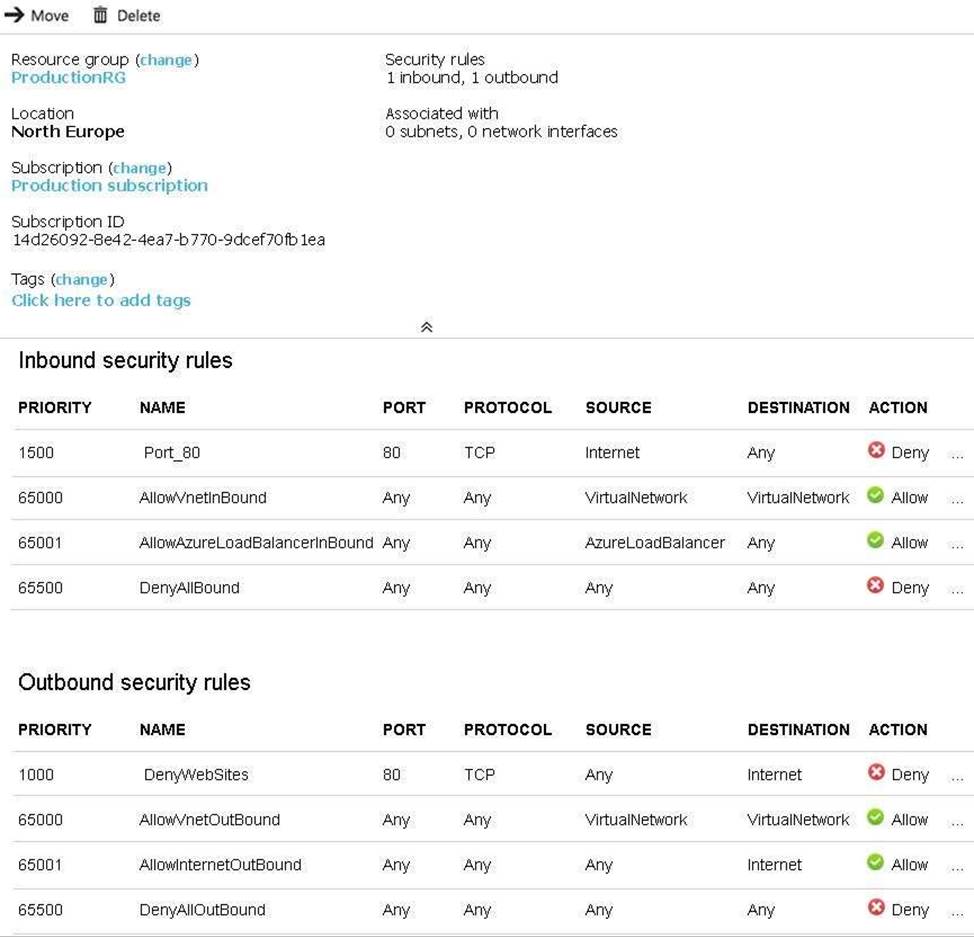
You need to prevent users of VM1 and VM2 from accessing websites on the Internet.
What should you do?
- A . Associate the NSG to Subnet1.
- B . Disassociate the NSG from a network interface.
- C . Change the DenyWebSites outbound security rule.
- D . Change the Port_80 inbound security rule
A
Explanation:
Outbound rule “DenyWebSites” is setup correctly to block outbound internet traffic over port 80. In the screenshot it states, "Associated with: 0 subnets, 0 NIC’s", so you need to associate the NSG to Subnet1.You can associate or dissociate a network security group from a NIC or Subnet.
Reference: https://docs.microsoft.com/en-us/azure/virtual-network/manage-network-security-group
You have an Azure subscription that contains a storage account named storage.
You have the devices shown in the following table.

From which devices can you use AzCopy to copy data to storage1?
- A . Device1 and Device2 only
- B . Device1, Device2 and Device3
- C . Device’ only
- D . Device and Device3 only
B
Explanation:
https://learn.microsoft.com/en-us/azure/storage/common/storage-use-azcopy-v10#download-azcopy
HOTSPOT
You have an Azure subscription.
You plan to use Azure Resource Manager templates to deploy 50 Azure virtual machines that will be part of the same availability set.
You need to ensure that as many virtual machines as possible are available if the fabric fails or during servicing.
How should you configure the template? To answer, select the appropriate options in the answer area. NOTE: Each correct selection is worth one point.

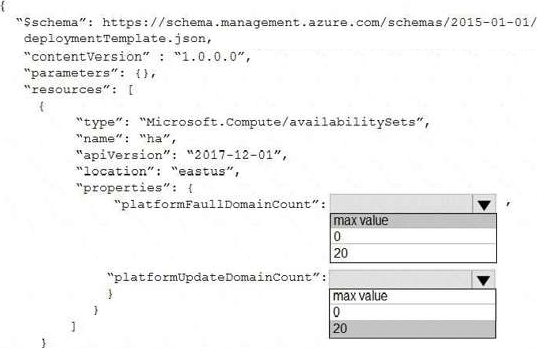
Explanation:
Box 1 = max value
Box 2 = 20
Explanation
Use max for platformFaultDomainCount
2 or 3 is max value, depending on which region you are in.
Use 20 for platformUpdateDomainCount
Increasing the update domain (platformUpdateDomainCount) helps with capacity and availability planning when the platform reboots nodes. A higher number for the pool (20 is max) means that fewer of their nodes in any given availability set would be rebooted at once.
Reference:
https://www.itprotoday.com/microsoft-azure/check-if-azure-region-supports-2-or-3-fault-domains-managed-disks
https://github.com/Azure/acs-engine/issues/1030
HOTSPOT
You have an Azure container registry named contoso2023 as shown in the following exhibit.



HOTSPOT
You implement the planned changes for cont2.
What is the maximum number of additional access policies you can create for cont2? To answer, select the appropriate options in the answer area. NOTE: Each correct selection is worth one point.


HOTSPOT
You have an Azure subscription that contains the vaults shown in the following table.

You create a storage account that contains the resources shown in the following table.

To which vault can you back up cont1 and share1? To answer, select the appropriate options in the answer area. NOTE: Each correct answer is worth one point.

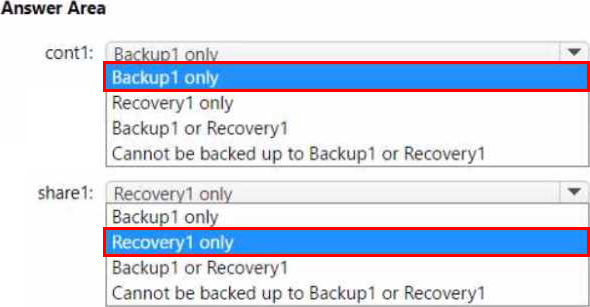
HOTSPOT
You have an Azure subscription that contains the container images shown in the following table.
![]()
You plan to use the following services:
• Azure Container Instances
• Azure Container Apps
• Azure App Service
In which services can you run the images? To answer, select the options in the answer area. NOTE: Each correct answer is worth one point.
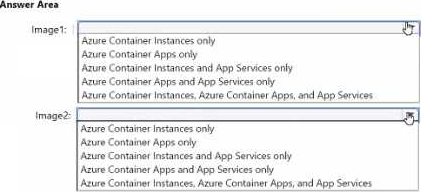

Explanation:
Image 1: Azure Container Apps only.image 2: Azure Container Instances, Azure Container Apps, and App Services.
The images you have in your Azure subscription are different types of container images that can run on different Azure services. A container image is a package of software that includes everything needed to run an application, such as code, libraries, dependencies, and configuration files. Container images are portable and consistent across different environments, such as development, testing, and production.
Azure Container Instances is a service that allows you to run containers directly on the Azure cloud, without having to manage any infrastructure or orchestrators. You can use Azure Container Instances to run any container image that is compatible with the Docker image format and follows the Open Container Initiative (OCI) specification. You can also run Windows or Linux containers on Azure Container Instances.
Azure Container Apps is a service that allows you to build and deploy cloud-native applications and microservices using serverless containers. You can use Azure Container Apps to run any container image that is compatible with the Docker image format and follows the Open Container Initiative (OCI) specification. You can also run Windows or Linux containers on Azure Container Apps.
Azure App Service is a service that allows you to build and host web applications, mobile backends, and RESTful APIs using various languages and frameworks. You can use Azure App Service to run custom container images that are compatible with the Docker image format and follow the App Service Docker image contract. You can also run Windows or Linux containers on Azure App Service.
You plan to create the Azure web apps shown in the following Table.

What is the minimum number of App Service plans you should create for the web apps?
- A . 1
- B . 2
- C . 3
- D . 4
B
Explanation:
NET Core 3.0: Windows and Linux ASP .NET V4.7: Windows only PHP 7.3: Windows and Linux Ruby 2.6: Linux only Also, you can’t use Windows and Linux Apps in the same App Service Plan, because when you create a new App Service plan you have to choose the OS type. You can’t mix Windows and Linux apps in the same App Service plan. So, you need 2 ASPs.
Reference: https://docs.microsoft.com/en-us/azure/app-service/overview
